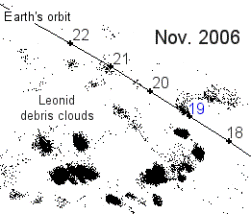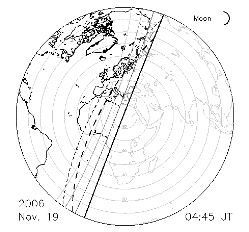Wishing On A Star

_______________________________________________________
"These Leonids are shooting right through the Southern Cross."
The Leonids 2001 by Greg Quicke, Broome, Western Australia Nov. 18
Expect a Meteor shower of Leonids on Sunday, Nov. 19th
Earth will pass through a stream of debris from comet 55P/Tempel-Tuttle
"We expect an outburst of more than 100 Leonids per hour," says Bill Cooke, the head of NASA's Meteoroid Environment Office in Huntsville, AL. This pales in comparison to the Leonid storms of 2001 and 2002, when sky watchers saw thousands of meteors. Even so, a hundred per hour would make the Leonids one of the best showers of 2006.
The mid-November region of Earth's orbit is littered with debris from Comet Tempel-Tuttle. Every time the comet visits the inner solar system (once every 33 years), it lays down a new stream of dust, pebbles and rock. This creates a sort of "minefield" for Earth to navigate every November.
Not all of these debris streams are alike. For example: A Leonid stream we hit in 1998 was full of rock-sized debris. They made brilliant fireballs when they hit the atmosphere. The stream we're hitting this year is just the opposite. It's mostly fine dust.
 Left: A minefield of Leonid debris streams. The streams intersect the plot at nearly right angles, so they resemble 2D clouds rather than 3D filaments. Credit J. Vaubaillon.
Left: A minefield of Leonid debris streams. The streams intersect the plot at nearly right angles, so they resemble 2D clouds rather than 3D filaments. Credit J. Vaubaillon.Debris streams are segregated—dusty vs. rocky—by the force of sunlight. Consider the stream directly ahead of us: "It was ejected from the comet in 1933," says Cooke. "At first, the debris was a mixture of many sizes." But as years passed, the smaller particles diverged from the larger ones. Radiation pressure—the delicate pressure of sunlight itself—pushed the light dust onto a collision course with Earth. Heavier rock-sized fragments resisted the pressure and lagged behind.
Perhaps in some future year we'll encounter the larger debris from 1933 and receive an overdue display of fireballs. How would they get here? "Nudged by Jupiter," suggests Cooke. Jupiter's gravity is strong enough to alter the course of heavier fragments. Indeed, by guiding debris toward us, Jupiter is indirectly responsible for many bright Leonid displays in the past.
 While meteor forecasters have done a splendid job predicting Leonid outbursts in recent years — they could be wrong in 2006. The outburst might happen at an unexpected time or it might be better than expected.
While meteor forecasters have done a splendid job predicting Leonid outbursts in recent years — they could be wrong in 2006. The outburst might happen at an unexpected time or it might be better than expected.Cooke urges enthusiasts everywhere to keep an eye out for Leonid meteors the nights of Nov. 17th – 19th. "The best time to look," he says, "is just before local dawn when the constellation Leo is high in the sky."
Leonid Photo Gallery Meteors 2001
Return of the Leonids NASA 14 Nov 2006
_______________________________________________________
_______________________________________________________
Discovering the Quantum Universe by Plato
What is dark matter -/- dark energy by Plato
The Three Ring Circus - dark energy by Plato
_______________________________________________________
Have a great weekend, and don't forget "Make a Wish" - Quasar9
_______________________________________________________
_______________________________________________________


<< Home